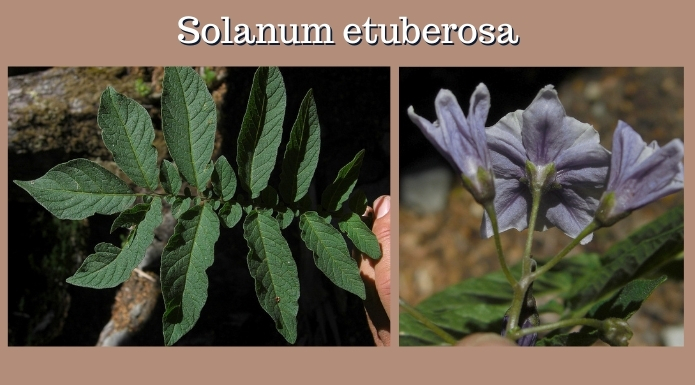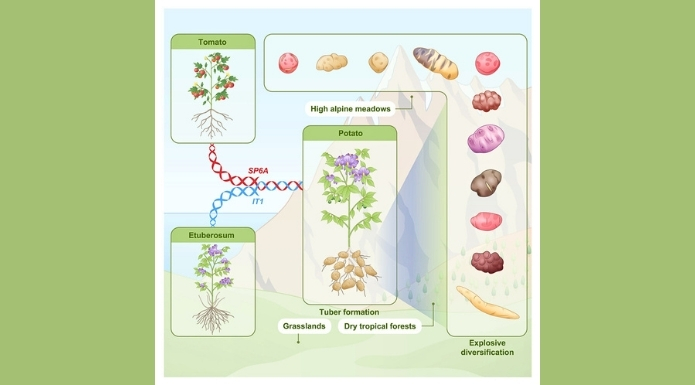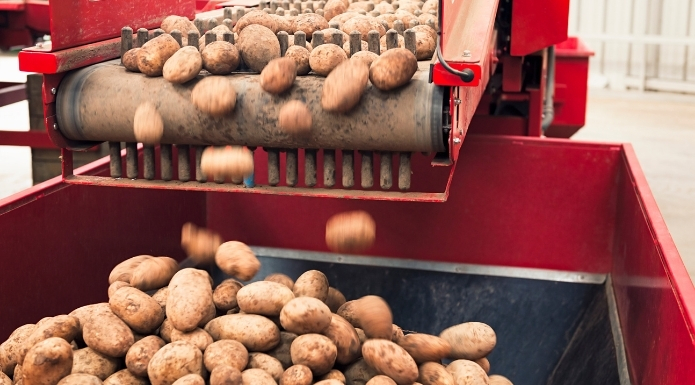The potato is the third most widely consumed food in the world after rice and wheat. The significance of its role in the world’s food supply cannot be overstated. First cultivated in the Andes Mountains of South America, this vital plant has long presented a mystery to botanists. Where did it come from? The plants potatoes most resemble, three potato-like species from Chile called Solanum etuberosum, don’t have underground tubers. There has long been a missing link between these plants and our modern potato plant with its efficient underground energy storage device. Now, scientists have finally solved this mystery. The origin of the potato has been found!

The wild “potato” plants from Chile called Etuberosum were named from the Latin word “tuber,” meaning swelling (or basically tuber), and the prefix E- meaning “without.” In other words, their name means “without tubers.” While modern cultivated potato plants are almost identical to these plants in appearance, they are genetically more closely related to tomatoes. Despite this, efforts to truly hybridize potatoes and tomatoes to produce a novel and useful plant have failed. The so-called pomato plant is simply a grafting of a tomato plant on a potato, not a true hybrid.

To solve the mystery of why potatoes are more closely related to tomatoes than the plants they resemble, researchers analyzed 450 genomes from cultivated potatoes and 56 wild potato species and published their findings in the Cell Press journal Cell. 1Zhiyang Zhang, Pingxian Zhang, Yiyuan Ding, Zefu Wang, Zhaoxu Ma, Edeline Gagnon, Yuxin Jia, Lin Cheng, Zhigui Bao, Zinan Liu, Yaoyao Wu, Yong Hu, Qun Lian, Weichao Lin, Nan Wang, Keyi Ye, Hongru Wang, Jinzhe Zhang, Yongfeng Zhou, Liang Liu, Suhua Li, William J. Lucas, Tiina Särkinen, Sandra Knapp, Loren H. Rieseberg, Jianquan Liu, Sanwen Huang. Ancient hybridization underlies tuberization and radiation of the potato lineage. Cell, 2025; DOI: 10.1016/j.cell.2025.06.034
Interspecific hybridization may trigger species radiation by creating allele combinations and traits. Cultivated potato and its 107 wild relatives from the Petota lineage all share the distinctive trait of underground tubers, but the underlying mechanisms for tuberization and its relationship to extensive species diversification remain unclear. Through analyses of 128 genomes, including 88 haplotype-resolved genomes, we revealed that Petota is of ancient hybrid origin, with all members exhibiting stable mixed genomic ancestry, derived from the Etuberosum and Tomato lineages ca. 8–9 million years ago. Our functional experiments further validated the crucial roles of parental genes in tuberization, indicating that interspecific hybridization is a key driver of this innovative trait. This trait, along with the sorting and recombination of hybridization-derived polymorphisms, likely triggered the explosive species diversification of Petota by enabling occupation of broader ecological niches. These findings highlight how ancient hybridization fosters key innovation and drives subsequent species radiation. 2Zhiyang Zhang, Pingxian Zhang, Yiyuan Ding, Zefu Wang, Zhaoxu Ma, Edeline Gagnon, Yuxin Jia, Lin Cheng, Zhigui Bao, Zinan Liu, Yaoyao Wu, Yong Hu, Qun Lian, Weichao Lin, Nan Wang, Keyi Ye, Hongru Wang, Jinzhe Zhang, Yongfeng Zhou, Liang Liu, Suhua Li, William J. Lucas, Tiina Särkinen, Sandra Knapp, Loren H. Rieseberg, Jianquan Liu, Sanwen Huang. Ancient hybridization underlies tuberization and radiation of the potato lineage. Cell, 2025; DOI: 10.1016/j.cell.2025.06.034
What they found is that every potato species contains a balance of genetic material from both Etuberosum and tomato plants. This suggests that a spontaneous hybridization event between the two plants gave rise to the first potato plants with tubers, starting around 9 million years ago. Both potatoes and tomatoes shared a common ancestor about 14 million years ago, but had long since diverged. Regardless, they were able to interbreed at some point, creating one of the most important human foods that ever existed.
Both the tomato and the wild potato ancestors contributed important pieces of the puzzle. The potato plant contained an important gene called IT1. This gene controls the growth of underground stems that become tubers. Even today, some wild potatoes have swollen underground stems, called rhizomes. Ginger and turmeric roots are rhizomes, for example. The tomato plant contained an equally important gene called SP6A, which behaves like an on or off switch: It tells the plant when to start making a tuber.
These new tuber-producing plants had several advantages. Their emergence corresponded with a major upshift in the Andes mountains and harsh weather conditions. Being able to store nutrients underground enabled potatoes to survive harsh mountain winters. At the same time, the tubers allowed them to reproduce without pollination. They were able to grow new plants by just sprouting from buds or “eyes” on the potato tubers. These two traits helped potatoes spread to many different ecologies and made them a perfect plant for human cultivation. 1Cell Press. “Scientists just solved the 9-million-year mystery of where potatoes came from.” ScienceDaily. ScienceDaily, 1 August 2025. www.sciencedaily.com/releases/2025/08/250801021017.htm.







